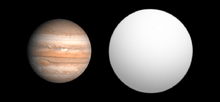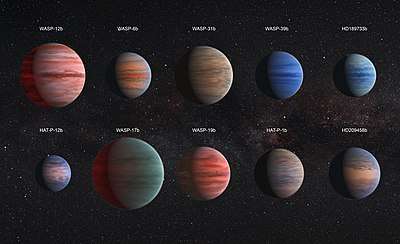WASP-19b
WASP-19b is an extrasolar planet, notable for possessing one of the shortest orbital periods of any known planetary body: 0.7888399 days or approximately 18.932 hours. It has a mass close to that of Jupiter (1.15 Jupiter masses), but by comparison has a much larger radius (1.31 times that of Jupiter, or 0.13 Solar radii); making it nearly the size of a low-mass star.[1] It orbits the star WASP-19 in the Vela constellation. At the time of discovery it was the shortest period hot Jupiter discovered as planets with shorter orbital periods had a rocky, or metallic composition.
 Size comparison of WASP-19b with Jupiter. | |
| Discovery | |
|---|---|
| Discovered by | Hebb et al. (SuperWASP)[1] |
| Discovery date | December 10, 2009[1] |
| Transit[1] | |
| Orbital characteristics | |
| 0.01655±0.00013 AU | |
| Eccentricity | 0.0046+0.0044 −0.0028[2] |
| 0.78884±0.0000003[1] d 18.93216 h | |
| Inclination | 79.4±0.4[2] |
| Star | WASP-19 |
| Physical characteristics | |
Mean radius | 1.386±0.032[2] RJ |
| Mass | 1.168±0.023[2] MJ |
Mean density | 680 kg/m3 (1,150 lb/cu yd) |
| Albedo | <0.26 [3] 0.16±0.04[4] |
| Temperature | 2350+168 −314[5] 2240±40[4] |
In 2013, secondary eclipse and orbital phases were barely observed from the data gathered with ASTEP telescope, making it the first detection of such kind through ground-based observations. This was possible due to large size of the planet and its small semi-major axis.[3]
In 2019 the planet was observed with TESS and the eclipse of the planet was measured. The broad variations caused by the changing aspect of the heated face of the planet were measured. The study deduced that the dayside has a temperature of 2240 ± 40 K (1967 ± 40 °C) and that the planet reflects 16 ± 4 percent of the light that falls on it.The last value is relatively high compared to other planets.[6][4]
Atmosphere
In December 2013, scientists working with the Hubble Space Telescope reported detecting water in the atmosphere of the exoplanet.[7][8]
In September 2017, astronomers using the Very Large Telescope at the European Southern Observatory reported the detection of titanium oxide (TiO) in WASP-19b's atmosphere.[5] This was the first time titanium oxide had been detected in an exoplanet atmosphere.[9] They also detected a strongly scattering haze in the atmosphere as well as the element sodium, and additionally confirmed the presence of water.[5]
A study using TESS data concluded that the atmosphere of WASP-19b is moderately efficient at transporting heat from the dayside to the nightside.[4]
References
- Hebb, L.; et al. (2010). "WASP-19b: The Shortest Period Transiting Exoplanet Yet Discovered". The Astrophysical Journal. 708 (1): 224–231. arXiv:1001.0403. Bibcode:2010ApJ...708..224H. doi:10.1088/0004-637X/708/1/224.
- "Notes for planet WASP-19b". The Extrasolar Planets Encyclopaedia. Retrieved 2009-12-10.
- Abe, L.; Gonçalves, I.; Agabi, A.; Alapini, A.; Guillot, T.; Mékarnia, D.; Rivet, J.-P.; Schmider, F.-X.; Crouzet, N.; Fortney, J.; Pont, F.; Barbieri, M.; Daban, J.-B.; Fanteï-Caujolle, Y.; Gouvret, C.; Bresson, Y.; Roussel, A.; Bonhomme, S.; Robini, A.; Dugué, M.; Bondoux, E.; Péron, S.; Petit, P.-Y.; Szulágyi, J.; Fruth, T.; Erikson, A.; Rauer, H.; Fressin, F.; Valbousquet, F.; et al. (2013). "The secondary eclipses of WASP-19b as seen by the ASTEP 400 telescope from Antarctica". Astronomy & Astrophysics. 553: A49. arXiv:1303.0973. Bibcode:2013A&A...553A..49A. doi:10.1051/0004-6361/201220351.
- Wong, Ian; Benneke, Björn; Shporer, Avi; Fetherolf, Tara; Kane, Stephen R.; Ricker, George R.; Vanderspek, Roland; Seager, Sara; Winn, Joshua N.; Collins, Karen A.; Mireles, Ismael; Morris, Robert; Tenenbaum, Peter; Ting, Eric B.; Rinehart, Stephen; Villaseñor, Jesus Noel (2019-12-13). "TESS Phase Curve of the Hot Jupiter WASP-19b". arXiv:1912.06773 [astro-ph.EP].
- Sedaghati, Elyar; et al. (2017). "Detection of titanium oxide in the atmosphere of a hot Jupiter". Nature. 549 (7671): 238–241. arXiv:1709.04118. Bibcode:2017Natur.549..238S. doi:10.1038/nature23651.
- waspplanets (2019-12-19). "TESS phase curve of WASP-19b". WASP Planets. Retrieved 2020-01-01.
- Staff (3 December 2013). "Hubble Traces Subtle Signals of Water on Hazy Worlds". NASA. Retrieved 4 December 2013.
- Mandell, Avi M.; et al. (2013). "Exoplanet Transit Spectroscopy Using WFC3: WASP-12 b, WASP-17 b, and WASP-19 b". Astrophysical Journal. 779 (2). 128. arXiv:1310.2949. Bibcode:2013ApJ...779..128M. doi:10.1088/0004-637X/779/2/128.
- "Inferno World with Titanium Skies" (Press release). European Southern Observatory. September 13, 2017. Retrieved December 24, 2017.
